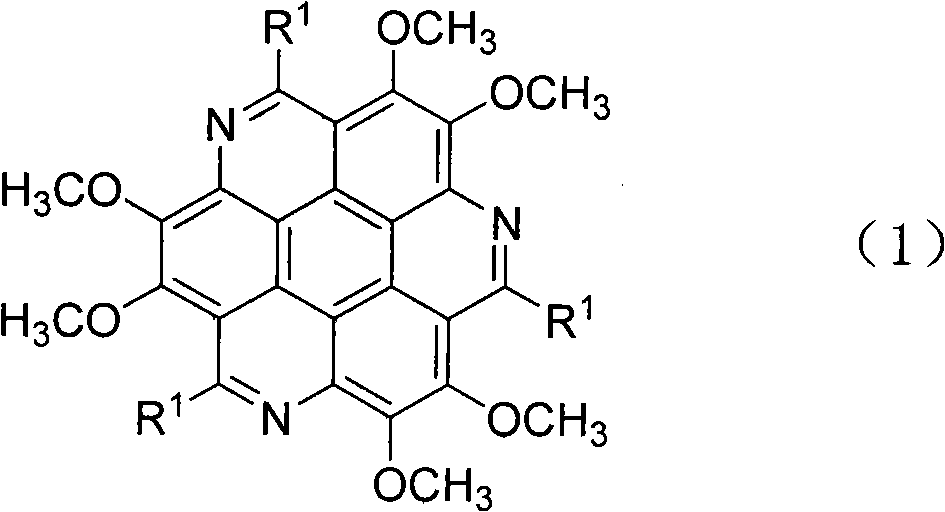S-triazacoronene compound and synthesis method and application thereof
A technology for the synthesis of s-triazepines, which is applied in chemical instruments and methods, organic chemistry, electrical components, etc., can solve the problems of low yield, scientific research development, long design route, harsh conditions, etc., and achieve good thermal stability and chemical stability, convenient operation, and mild reaction conditions
- Summary
- Abstract
- Description
- Claims
- Application Information
AI Technical Summary
Problems solved by technology
Method used
Image
Examples
Embodiment 1
[0028] Taking the synthesis of 2,3,6,7,10,11-hexamethoxy-4,8,12-triphenyl-1,5,9-triazepine as an example, its structural formula is as follows:
[0029]
[0030] The raw materials used and their synthetic methods are:
[0031] 1. Synthesis of 2,3,6,7,10,11-hexamethoxytriphenylene
[0032] Dissolve 23.00g of phthalic dimethyl ether in a flask filled with 500mL of dichloromethane, add 81.00g of anhydrous ferric chloride and 1.60g of concentrated sulfuric acid, and mix phthalic dimethyl ether with dichloromethane and anhydrous trichloride The molar ratio of iron and sulfuric acid was 1:16:3:0.04, stirred and reacted at 25°C for 4 hours, filtered, washed with methanol until the solid was off-white, and dried in a vacuum oven at 100°C for 5 hours to prepare 2,3, 6,7,10,11-hexamethoxytriphenylene with a yield of 89%.
[0033] 2. Synthesis of 1,5,9-trinitro-2,3,6,7,10,11-hexamethoxytriphenylene
[0034] Dissolve 3.0g of 2,3,6,7,10,11-hexamethoxytriphenylene in a mixture of 15.0...
Embodiment 2
[0046] Taking the synthesis of 2,3,6,7,10,11-hexamethoxy-4,8,12-three-(p-methoxyphenyl)-1,5,9-triazepine as an example, its structural formula as follows:
[0047]
[0048] The raw materials used and their synthetic methods are:
[0049] In step 4 of the present embodiment, benzaldehyde is replaced with equimolar p-methoxybenzaldehyde, and the volume ratio of ethyl acetate and petroleum ether is a mixed solution of 1:5 as a developing agent to separate the product by column chromatography, Recrystallize with acetone or tetrahydrofuran, and the other steps of this step are the same as in Example 1. The other steps are the same as in Example 1, and the yellow needle-like solid 2,3,6,7,10,11-hexamethoxy-4,8,12-tri-(p-methoxyphenyl)-1,5 , 9-triazepine, the yield is 66%, and the melting point is 287-289°C.
[0050] The spectral data of the resulting product are as follows:
[0051] 1 H NMR (300MHz, CDCl 3 +TMS)δ(ppm): 7.16(d, J=6.9Hz, 6H), 7.95(d, J=6.9Hz, 6H), 4.57(s, 9H...
Embodiment 3
[0057] Taking the synthesis of 2,3,6,7,10,11-hexamethoxy-4,8,12-tri-(p-bromophenyl)-1,5,9-triazepine as an example, its structural formula is as follows:
[0058]
[0059] The raw materials used and their synthetic methods are:
[0060] In step 4 of this embodiment, benzaldehyde is replaced by equimolar p-bromobenzaldehyde, and column chromatography is performed with a mixed solution of chloroform, ethyl acetate, and petroleum ether in a volume ratio of 1:1:5 as a developing solvent. The product was isolated by method and recrystallized with tetrahydrofuran. The other steps of this step were the same as in Example 1. The other steps are the same as in Example 1, and the yellow flake solid 2,3,6,7,10,11-hexamethoxy-4,8,12-tri-(p-bromophenyl)-1,5,9 - Triazepines with a yield of 54% and a melting point greater than 300°C.
[0061] The spectral data of the resulting product are as follows:
[0062] 1 HNMR (300MHz, CDCl 3 +TMS) δ (ppm): 7.80 (d, J = 7.83Hz, 6H), 7.75 (d, J...
PUM
 Login to View More
Login to View More Abstract
Description
Claims
Application Information
 Login to View More
Login to View More - R&D
- Intellectual Property
- Life Sciences
- Materials
- Tech Scout
- Unparalleled Data Quality
- Higher Quality Content
- 60% Fewer Hallucinations
Browse by: Latest US Patents, China's latest patents, Technical Efficacy Thesaurus, Application Domain, Technology Topic, Popular Technical Reports.
© 2025 PatSnap. All rights reserved.Legal|Privacy policy|Modern Slavery Act Transparency Statement|Sitemap|About US| Contact US: help@patsnap.com



